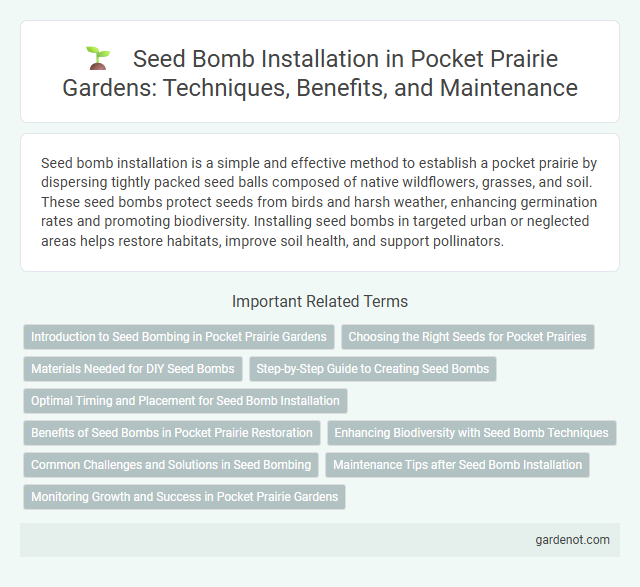Seed bomb installation is a simple and effective method to establish a pocket prairie by dispersing tightly packed seed balls composed of native wildflowers, grasses, and soil. These seed bombs protect seeds from birds and harsh weather, enhancing germination rates and promoting biodiversity. Installing seed bombs in targeted urban or neglected areas helps restore habitats, improve soil health, and support pollinators.
Introduction to Seed Bombing in Pocket Prairie Gardens
Seed bomb installation in Pocket Prairie gardens enhances biodiversity by dispersing native wildflower seeds encased in nutrient-rich clay and compost balls. These seed bombs facilitate natural germination in disturbed soil areas, promoting pollinator habitats and improving soil health. Implementing seed bombing supports sustainable urban greening efforts and adaptive ecosystem restoration strategies.
Choosing the Right Seeds for Pocket Prairies
Selecting native wildflower and grass seeds adapted to local soil and climate conditions ensures optimal growth and supports regional biodiversity in pocket prairies. Emphasizing drought-tolerant and pollinator-friendly species enhances ecological resilience and promotes habitat for native bees, butterflies, and birds. Using a diverse seed mix with varying bloom times maximizes seasonal floral resources and improves soil health through improved root structures.
Materials Needed for DIY Seed Bombs
Creating DIY seed bombs for pocket prairie restoration requires key materials including native wildflower seeds, biodegradable clay powder, and organic compost or soil. Using local wildflower varieties ensures adaptation to the ecosystem while clay binds the mixture, protecting seeds during dispersal. Organic compost enriches the seed bombs with nutrients, promoting strong germination and healthy prairie growth.
Step-by-Step Guide to Creating Seed Bombs
Start by mixing 5 parts clay powder, 1 part compost, and 1 part native wildflower seeds in a large bowl to form a moldable dough. Roll the mixture into small balls about the size of a marble, then place them on a tray and allow to dry for 24-48 hours until they are firm. Once dry, scatter the seed bombs in bare or disturbed soil areas to promote native plant growth and enhance local biodiversity.
Optimal Timing and Placement for Seed Bomb Installation
Seed bomb installation in pocket prairies achieves optimal growth when timed during early spring or early fall, aligning with natural rainfall patterns to enhance seed germination. Placement should target disturbed, bare soil areas with sufficient sunlight exposure, avoiding dense shade or overly compacted ground to maximize seed-to-soil contact and moisture retention. Selecting locations near native plant clusters also promotes biodiversity and supports pollinator habitats within the pocket prairie ecosystem.
Benefits of Seed Bombs in Pocket Prairie Restoration
Seed bombs enhance pocket prairie restoration by efficiently dispersing native wildflower and grass seeds in compact, nutrient-poor soils, promoting biodiversity and habitat creation for pollinators. Their biodegradable composition protects seeds from predation and harsh environmental conditions, increasing germination rates and plant establishment success. This low-impact method supports cost-effective, large-scale revegetation efforts that improve soil health, carbon sequestration, and ecosystem resilience.
Enhancing Biodiversity with Seed Bomb Techniques
Seed bomb installation boosts biodiversity by dispersing native wildflower seeds efficiently across urban or degraded areas, promoting habitat restoration and supporting pollinators such as bees and butterflies. This low-impact technique improves soil health and increases plant variety, creating resilient ecosystems in pocket prairies. Using seed bombs in targeted locations accelerates natural regeneration processes and enhances ecological balance within small green spaces.
Common Challenges and Solutions in Seed Bombing
Seed bomb installation in pocket prairies often faces challenges such as uneven seed distribution and poor germination rates due to soil compaction or insufficient moisture. Utilizing lightweight, biodegradable seed bombs infused with native grasses and wildflowers improves seed dispersal and enhances germination success. Incorporating organic matter and applying seed bombs during optimal weather conditions further addresses these issues, promoting robust prairie establishment.
Maintenance Tips after Seed Bomb Installation
Maintaining a seed bomb installation in a pocket prairie requires regular monitoring to ensure seed germination and plant health. Watering the area lightly during dry spells supports seedling establishment, while removing invasive weeds prevents competition for nutrients. Mulching around emerging plants helps retain moisture and improve soil quality, promoting a thriving, biodiverse pocket prairie.
Monitoring Growth and Success in Pocket Prairie Gardens
Monitoring growth and success in pocket prairie gardens involves regular observation and documentation of plant germination, height, and diversity following seed bomb installation. Detailed tracking using photographic evidence and growth charts helps assess seed viability and ecosystem development over time. Implementing soil health tests further ensures optimal conditions for native plant establishment and biodiversity enhancement.
Seed bomb installation Infographic

 gardenot.com
gardenot.com